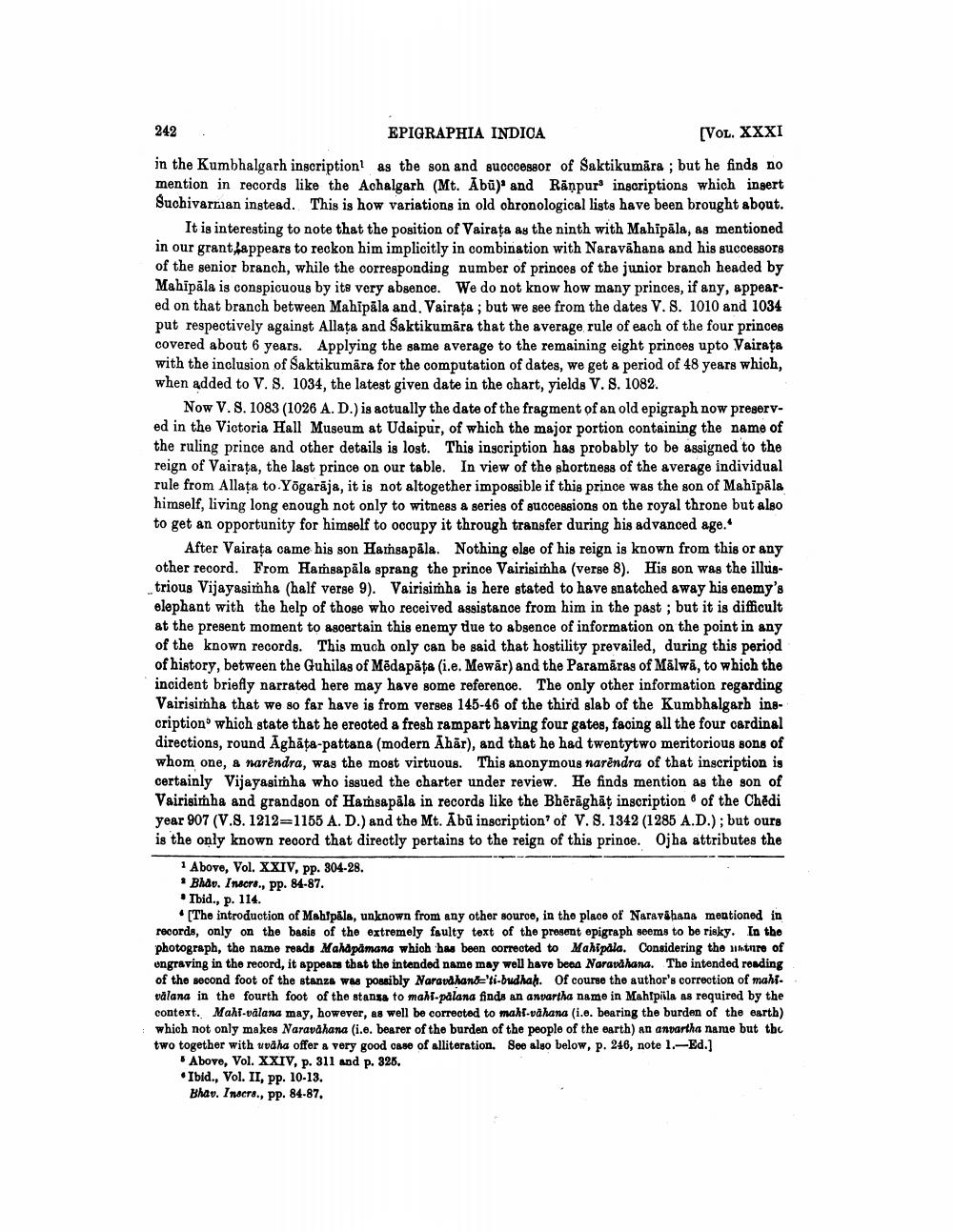________________
EPIGRAPHIA INDICA
[VOL. XXXI in the Kumbhalgarh inscription as the son and succcessor of Saktikumāra ; but he finds no mention in records like the Achalgarh (Mt. Abu)' and Ranpurs inscriptions which insert Suchivarmaan instead. This is how variations in old chronological lists have been brought about.
242
It is interesting to note that the position of Vairața as the ninth with Mahipala, as mentioned in our grant appears to reckon him implicitly in combination with Naravahana and his successors of the senior branch, while the corresponding number of princes of the junior branch headed by Mahipala is conspicuous by its very absence. We do not know how many princes, if any, appeared on that branch between Mahipala and. Vairața; but we see from the dates V. S. 1010 and 1034 put respectively against Allața and Saktikumāra that the average rule of each of the four princes covered about 6 years. Applying the same average to the remaining eight princes upto Vairața with the inclusion of Saktikumara for the computation of dates, we get a period of 48 years which, when added to V. S. 1034, the latest given date in the chart, yields V. S. 1082.
Now V. S. 1083 (1026 A.D.) is actually the date of the fragment of an old epigraph now preserved in the Victoria Hall Museum at Udaipur, of which the major portion containing the name of the ruling prince and other details is lost. This inscription has probably to be assigned to the reign of Vairata, the last prince on our table. In view of the shortness of the average individual rule from Allaṭa to Yōgarāja, it is not altogether impossible if this prince was the son of Mahīpāla himself, living long enough not only to witness a series of successions on the royal throne but also to get an opportunity for himself to occupy it through transfer during his advanced age.
After Vairața came his son Hamsapala. Nothing else of his reign is known from this or any other record. From Hamsapala sprang the prince Vairisimha (verse 8). His son was the illustrious Vijayasimha (half verse 9). Vairisimha is here stated to have snatched away his enemy's elephant with the help of those who received assistance from him in the past; but it is difficult at the present moment to ascertain this enemy due to absence of information on the point in any of the known records. This much only can be said that hostility prevailed, during this period of history, between the Guhilas of Medapata (i.e. Mewar) and the Paramāras of Malwa, to which the incident briefly narrated here may have some reference. The only other information regarding Vairisimha that we so far have is from verses 145-46 of the third slab of the Kumbhalgarh inscription which state that he erected a fresh rampart having four gates, facing all the four cardinal directions, round Aghața-pattana (modern Ahär), and that he had twentytwo meritorious sons of whom one, a narendra, was the most virtuous. This anonymous narendra of that inscription is certainly Vijayasimha who issued the charter under review. He finds mention as the son of Vairisimha and grandson of Hamsapala in records like the Bheraghat inscription of the Chedi year 907 (V.S. 1212-1155 A. D.) and the Mt. Abu inscription" of V. S. 1342 (1285 A.D.); but ours is the only known record that directly pertains to the reign of this prince. Ojha attributes the
1 Above, Vol. XXIV, pp. 304-28.
Bhav. Inscrs., pp. 84-87.
Ibid., p. 114.
[The introduction of Mahipala, unknown from any other source, in the place of Naravahana mentioned in records, only on the basis of the extremely faulty text of the present epigraph seems to be risky. In the photograph, the name reads Mahapamana which has been corrected to Mahipala. Considering the nature of engraving in the record, it appears that the intended name may well have been Naravahana. The intended reading of the second foot of the stanza was possibly Naravahano-'ti-budhah. Of course the author's correction of mahi. valana in the fourth foot of the stanza to mahi-palana finds an anvartha name in Mahipüla as required by the context. Mahi-valana may, however, as well be corrected to mahi-vahana (i.e. bearing the burden of the earth) which not only makes Naravahana (i.e. bearer of the burden of the people of the earth) an anvartha name but the two together with uvaha offer a very good case of alliteration. See also below, p. 246, note 1.-Ed.]
Above, Vol. XXIV, p. 311 and p. 325.
Ibid., Vol. II, pp. 10-13.
Bhav. Inscrs., pp. 84-87.




